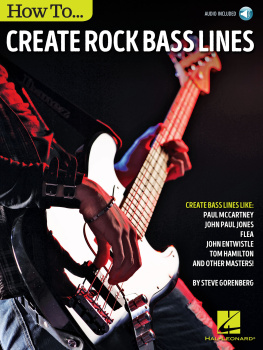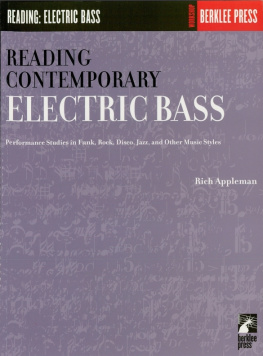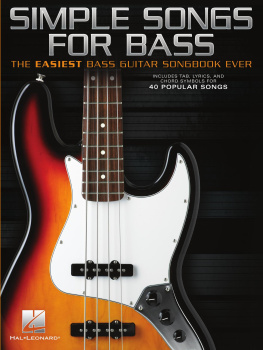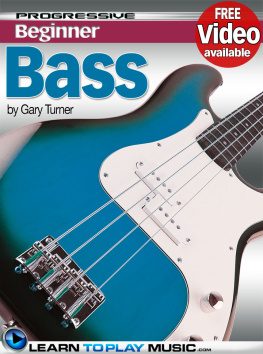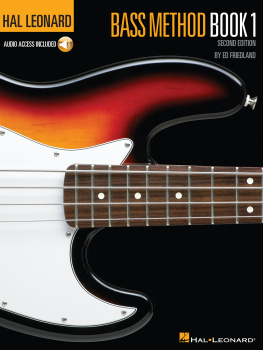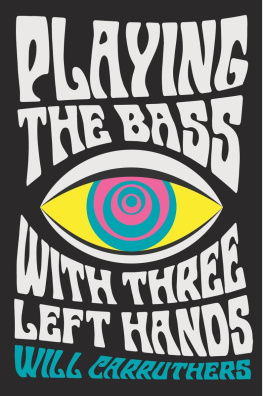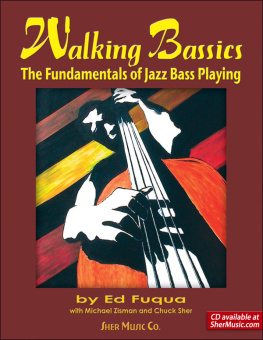Steve Gorenburg - How to Create Rock Bass Lines
Here you can read online Steve Gorenburg - How to Create Rock Bass Lines full text of the book (entire story) in english for free. Download pdf and epub, get meaning, cover and reviews about this ebook. year: 2016, publisher: Hal Leonard, genre: Children. Description of the work, (preface) as well as reviews are available. Best literature library LitArk.com created for fans of good reading and offers a wide selection of genres:
Romance novel
Science fiction
Adventure
Detective
Science
History
Home and family
Prose
Art
Politics
Computer
Non-fiction
Religion
Business
Children
Humor
Choose a favorite category and find really read worthwhile books. Enjoy immersion in the world of imagination, feel the emotions of the characters or learn something new for yourself, make an fascinating discovery.
- Book:How to Create Rock Bass Lines
- Author:
- Publisher:Hal Leonard
- Genre:
- Year:2016
- Rating:5 / 5
- Favourites:Add to favourites
- Your mark:
- 100
- 1
- 2
- 3
- 4
- 5
How to Create Rock Bass Lines: summary, description and annotation
We offer to read an annotation, description, summary or preface (depends on what the author of the book "How to Create Rock Bass Lines" wrote himself). If you haven't found the necessary information about the book — write in the comments, we will try to find it.
How to Create Rock Bass Lines — read online for free the complete book (whole text) full work
Below is the text of the book, divided by pages. System saving the place of the last page read, allows you to conveniently read the book "How to Create Rock Bass Lines" online for free, without having to search again every time where you left off. Put a bookmark, and you can go to the page where you finished reading at any time.
Font size:
Interval:
Bookmark:
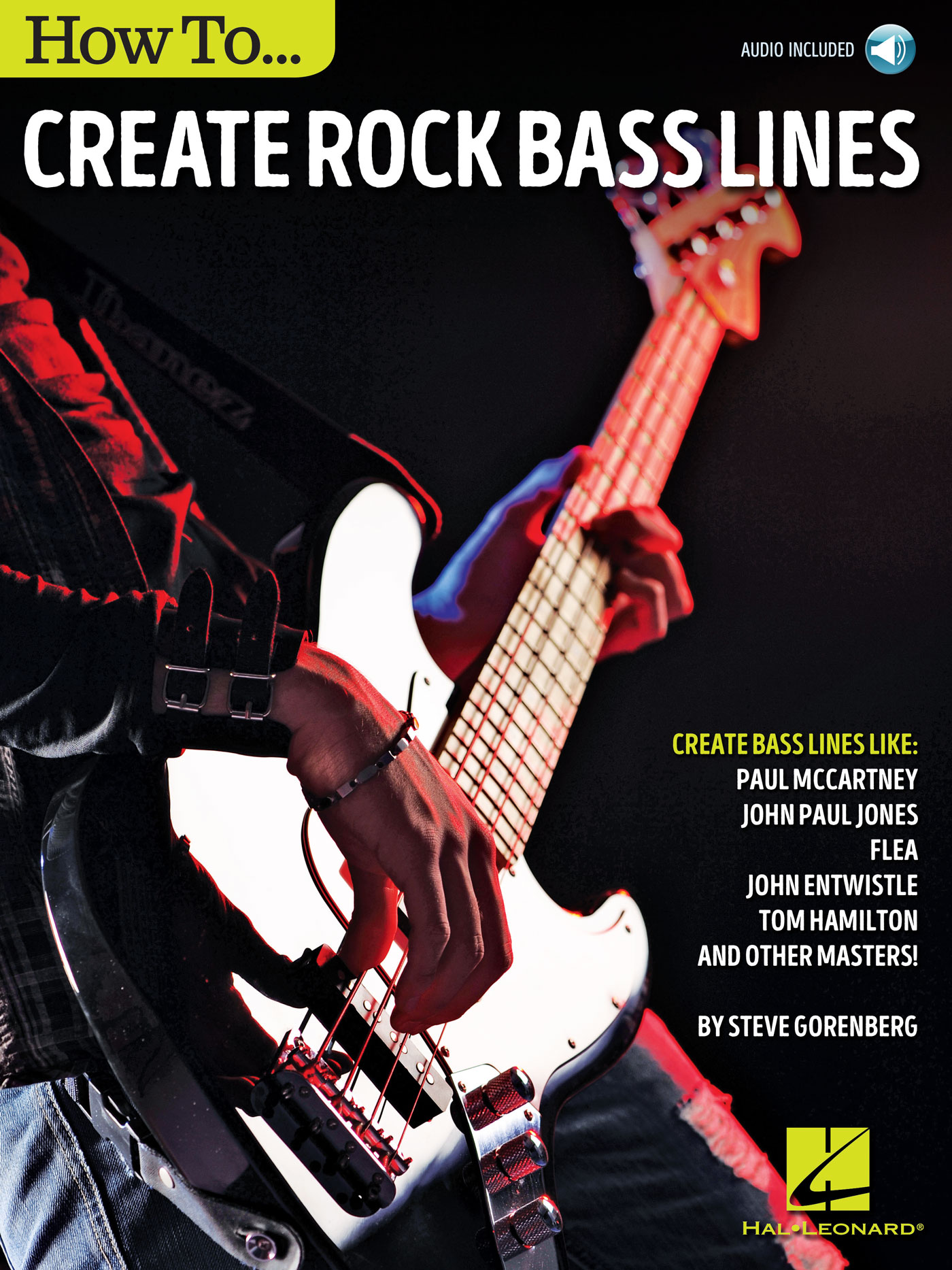

ISBN 978-1-4950-6450-0

7777 W. Bluemound Rd. P.O. Box 13819 Milwaukee, WI 53213
Copyright 2016 by HAL LEONARD CORPORATION
International Copyright Secured All Rights Reserved
No part of this publication may be reproduced in any form or by
any means without the prior written permission of the Publisher.
In Australia Contact:
Hal Leonard Australia Pty. Ltd.
4 Lentara Court
Cheltenham, Victoria, 3192 Australia
Visit Hal Leonard Online at
www.halleonard.com
The function of the bass player in rock music is multi-dimensional. A successful bass line can act as the glue that binds the rhythm, harmony, and melody together, while complementing all three elements. The bass is an integral part of the rhythm section, and learning how to play a solid groove is essential. An effective bass player will be familiar with the notes on the neck, chords, and scales, enabling him to complement the vocals, guitar, and keyboards, all while staying married to the drum beat.
In this book, youll explore common rock drum beats and how to lock in with them, popular rock chord progressions, and the scales and techniques youll need to add melody to your playing. By combining all of these elements, youll learn how to create your own bass lines that will stand out while still locking in with the drums and complementing the other instruments and vocals. Well also take a look at the styles of some of the rock bass greats like Paul McCartney, John Paul Jones, Flea, John Entwistle, and Duff McKagan.
Music examples accompany the lessons, so you can hear what each example sounds like. Backing tracks are also provided so you can jam along.
Special thanks to guitarist Chris Declercq for supplying the guitar parts featured on the audio tracks.
Steve Gorenberg is a bass player, music educator, author, arranger, transcriber, and music engraver based in Los Angeles. Steve started out at Cherry Lane Musics print division as a transcriber and in-house music editor. He has since continued as a freelance transcriber, editor, and engraver for Cherry Lane Music, Guitar for the Practicing Musician magazine, Hal Leonard Corp., Fred Russell Publishing, and Warner Bros. Inc., and has written, edited, and designed numerous music education products. To date, Steve has created thousands of official note-for-note guitar and bass transcriptions for artists including Metallica, Guns N Roses, the Red Hot Chili Peppers, the Rolling Stones, Van Halen, Pearl Jam, Rush, Black Sabbath, Queen, and John Mayer.
For each lesson chapter, listen to the audio track and try playing along with the music examples. When youve got them down, use the scales and ideas presented to create your own bass lines. The last section contains play-along tracks that showcase many of the drum beats and chord progressions used throughout the book. You can create your own bass lines for these tracks using all of the elements presented in the previous chapters.
At its very core, the bass is an essential part of the rhythm section. Any effective bass line is sure to lock in with the drummer, so the beat is a good place to start. Some of the simplest bass parts work extremely well when they follow the kick drum. The song Dreams by Fleetwood Mac comes to mindthe bass plays simple root notes along with the kick-drum pattern but still manages to create one of the most recognizable rock bass lines of all time. In this chapter, well concentrate on following the beat using mostly root notes to get you accustomed to commonly used rock drum patterns. Once youve developed an instinct for listening to the drummer and following the beat, youll be able to add melody and riffs to your playing while keeping the groove intact.
Lets begin with a basic rock drum beat, shown below in music notation. For the purposes of this book, well indicate drums on a musical staff using xs for noteheads. The downstemmed notes represent the kick drum, and the upstemmed notes represent the snare drum. The kick and snare pattern is the most important thing to listen for when building your bass lines, so dont be concerned with what the cymbals or other drums are doing at this point.

The following example is a simple two-chord progression, with the bass playing just the root notes, A and G, along with the above beat. Concentrate on memorizing and locking in with the kick drum pattern.

Now lets create a slight variation of the previous drum beat by adding an extra kick drum to beat 4 1/2.

Heres a variation of the previous bass line, adding a note on beat 4 1/2 of each measure.

This next example uses the same beat and adds bass notes for the snare-drum hits. In most rock music, the snare drum is played on beats 2 and 4i.e., the same beats you would clap on. These notes are shown below using accents in the notation for reading convenience. You dont need to heavily accent these notes when you play them, but adding a little extra kick to them will help you lock in better with the groove.

This next example is played to the same beat and adds a few other note choices to create a slightly more interesting bass line.

The following example has a solid kick drum on beats 1 and 3, but also places a kick drum on beat 2 1/2. This drum pattern and the variations that follow are commonly used, steady rock beats.
Font size:
Interval:
Bookmark:
Similar books «How to Create Rock Bass Lines»
Look at similar books to How to Create Rock Bass Lines. We have selected literature similar in name and meaning in the hope of providing readers with more options to find new, interesting, not yet read works.
Discussion, reviews of the book How to Create Rock Bass Lines and just readers' own opinions. Leave your comments, write what you think about the work, its meaning or the main characters. Specify what exactly you liked and what you didn't like, and why you think so.

